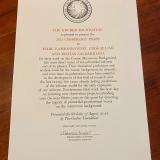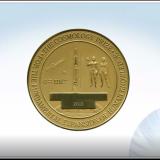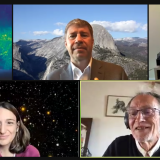2021 Gruber Cosmology Prize
Marc Kamionkowski, Uroš Seljak, and Matias Zaldarriaga have introduced numerous techniques for the study of the large-scale structure of the universe as well as the properties of its first instant of existence. Their work includes a mathematical means for studying the early universe that not only has allowed both theorists and observers to test and ultimately embrace a standard cosmological model but, in the coming decade, will allow researchers to probe the existence of gravitational waves in the so-called inflationary era, when the age of the universe was 10-35 seconds.
Matias Zaldarriaga Photo Credit: Andrea Kane, Institute for Advanced Study
2021 Cosmology Prize Recipients
Laureate Profile
The fundamental idea was out there: Cosmologists could learn the secrets of the early universe if only they found a way to decipher a riddle in the Cosmic Microwave Background. In 1997, two papers published back to back in Physical Review Letters showed them how.
Marc Kamionkowski, Uroš Seljak, and Matias Zaldarriaga are the recipients of the 2021 Gruber Cosmology Prize for their authorship of those papers as well as for numerous other contributions to cosmology since the mid-1990s.
The Cosmic Microwave Background dates to the period when the primordial plasma of the expanding universe had cooled enough that matter and radiation could decouple from each other and go their separate ways. That moment, when the universe was only 379,000 years old, remains visible today in the form of microwave radiation that pervades space in every direction. Although it serves as an observational limit—it’s the first light in the universe—the radiation contains information on what preceded it.
To decode that information, cosmologists assumed that they would have to interpret the patterns in the radiation—specifically, its polarization: the extent to which an oscillating wave, bouncing up and down relative to the direction of travel, does or does not diverge from a strictly perpendicular orientation. Two 1997 papers by Kamionkowski (along with co-authors Albert Stebbins and Arthur Kosowsky) and Seljak and Zaldarriaga provided the mathematical basis for translating that data.
That two collaborations would simultaneously arrive at the same means of reading the polarization data wasn’t surprising. “There was an obvious problem to solve,” Kamionkowski says.
“The level and intensity of activity in the U.S. was something else,” says Zaldarriaga, who had recently emigrated from Argentina. “Like a whole different game.”
The surprise instead was that the two collaborations used entirely different mathematical approaches yet arrived at the same solution. In fact, when Seljak first heard from a mutual colleague about the problem Kamionkowski was trying to solve, he thought, “That’s interesting—but I’m not interested in that.”
Kamionkowski was studying all-sky polarization—that is, the CMB. Seljak’s work on polarization, however, applied to small patches of the sky. But then Seljak learned that a frequent collaborator of his, Zaldarriaga, was also working on all-sky polarization. Another collaboration seemed inevitable.
“At the end of the day,” Kamionkowski says, “we had two really complicated papers, but when we sat down and tried to translate their expressions into our expressions and vice versa, everything agreed spot on.”
Those two papers immediately moved polarization to the forefront of CMB research, and there it has remained for more than two decades, allowing the WMAP and Planck satellite observatories to establish much of the standard cosmological model: that the universe is 13.8 billion years old and comprises roughly 5 percent ordinary matter, 26 percent dark matter, and 69 percent dark energy.
The last piece of that model is inflation, a theoretical moment at the very beginning of the universe’s existence when space would have undergone an expansion of almost unfathomable proportions. Here, too, the polarization work of Kamionkowski, Seljak, and Zaldarriaga will be indispensable. Over the next decade various experiments—some already in development—will be looking for a signature effect in the CMB polarization that, as the two 1997 papers established, would render a verdict on the existence of primordial gravitational waves, a key prediction of inflationary theory.
Although the 1997 papers are two of the seminal works by Kamionkowski, Seljak, and Zaldarriaga, the 2021 Gruber Prize also recognizes their career-long contributions to cosmology.
Even before writing their own 1997 paper, Seljak and Zaldarriaga had already created a code that made the study of certain aspects of the CMB thousands of times faster—in fact, they named it CMBfast. And because they made the code available for free it dominated CMB research for years to come. (Today it endures as the foundation for every code analyzing CMB polarization.) Over the decades, singly and together, they have continued to perform influential mathematical analyses and to create new theoretical interpretations in such areas as inflation, gravitational waves, and the use of general relativistic effects (weak lensing) on light from distant sources to infer the characteristics of the dark matter in individual galaxy halos as well as in the large-scale structure of galactic formation.
Kamionkowski is also well known for his work on cosmological-parameter determination and parity-breaking effects in the CMB, and he has similarly over the years made important subsequent contributions to the study of CMB polarization. He also has significant work in multiple other areas of cosmology, including dark matter, inflation, the acceleration of the expansion of the universe, cosmic phase transitions, and gravitational waves.
As for those two 1997 papers: In the words of one nominator for this year’s Gruber Prize, “The significance of this work for cosmology cannot be overstated.”
Watch Video
Citation
The Gruber Foundation is pleased to present the 2021 Cosmology Prize to Marc Kamionkowski, Uroš Seljak, and Matias Zaldarriaga for their work on the Cosmic Microwave Background, the most direct tracer of the primordial universe and of its physics. Their theoretical predictions and analysis tools for the cosmic background, its intensity, and even more its polarization, have been essential to the development of this field of research over the last twenty-five years, already testing predictions of the inflation model for the early expansion of our universe. Furthermore, their work has been key to initiating new observation projects extending over the next fifteen years, in the quest for detecting the imprint of primordial gravitational waves on the microwave background.






















